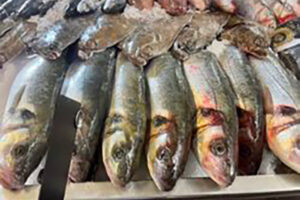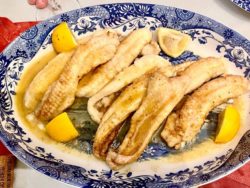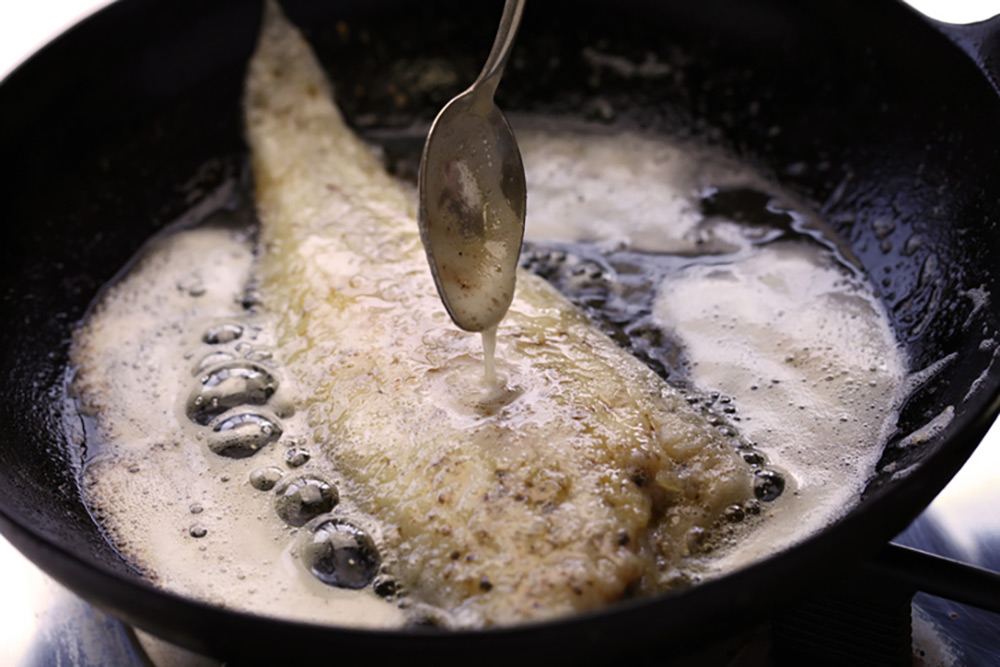After owning one of the best cooking stores in the US for 47 years—La Cuisine: the Cook’s Resource, in Alexandria, Virginia—Nancy Pollard now writes Kitchen Detail, a blog about food in all its aspects—recipes, film, books, travel, superior sources and food-related issues. She and her husband, the Resident Wine Maniac, have recently moved to Italy.

The Fish Portsmouth seafood shop in Portsmouth, England, makes Kitchen Detail’s Nancy Pollard weep with envy. / Photo by Nancy Pollard.
In Portsmouth, UK, Fish Portsmouth is a seafood shop in the Portsmouth Historic Dockyards that makes me weep with envy. They stay open until they sell out, which is usually in a few hours. One of the difficulties in my marriage to the Resident Wine Maniac is that I love seafood and he loves steak. Until we were introduced to Mas Seafood, any fish or crustacean menu was roundly snubbed by the RWM. His only exceptions were our blue-crab cakes and Sole Meunière. We have eaten excellent Dover Sole Meunière at the Rick Stein Restaurant in Winchester, England—lovely food, excellent service, and Rick Stein himself writes a mean cookbook.
I have made Sole Meunière with flounder, lemon sole, and occasionally farmed Dover Sole through Browne Trading Company in Portland, Maine. But this was my one chance to make it with a wild-caught one (just that morning) with some divine English butter. My son-in-law, who once worked on a fishing boat in Gosport, boned and skinned the fish, and I created the best Sole Meunière of my life. I can’t get you the same sole, but I can share this recipe.
Sole Advice
You can remove the gills (and head if you prefer), trim the sets of fins and pull off the skin and sauté the fish whole. Or you can remove the fillets once the skin is pulled off—there are about 4 or 5 to be had. I prefer this to having to remove the bones once it is cooked—although, in truth, it’s not that difficult. You should clarify the butter you fry the fish in first, easily done by melting the butter in the pan and then scooping out the “petit lait” or white residue. You must use a pan that responds quickly and evenly to medium heat. I normally use a carbon-steel pan currently available from JB Prince (my favorite source for real cooking utensils). It takes only a couple of minutes for a whole sole and less time for the fillets. Spoon the melted butter over the top of the fish as you sauté each side. Have your serving platter warm, lemon juice strained and in a small bowl, your lemons quartered, side garnishes ready (steamed potatoes and sautéed spinach are often served), and your parsley chopped. The RWM loves a white burgundy for this rare treat.
Sole Meunière

The sole fillets, dressed simply with butter and perked up with lemons. / Photo by Nancy Pollard.
Serves 2.
The simplest of preparations, but be prepared as it goes really quickly.
Recipe by Nancy Purves Pollard.
Adapted from The Cookbook of Hard Knocks.
- Usually one whole sole will serve two people, depending on the size
- Fine sea salt
- Freshly ground white pepper
- ¾ cup (95gr) white flour
- 1/3 cup (79ml) clarified butter
- 1/3 cup (79ml) strained lemon juice
- 1/3 cup (76gr) unsalted butter at room temperature
- 1 lemon quartered
- Parsley, chopped, for garnish
- Dry your fish pieces if necessary and then lightly salt and pepper each side.
- Put the flour on a large plate and coat each fillet with flour. You want a thin, even coat. I sometimes have to brush off extra clumps of flour.
- Put a fry pan on medium heat and add enough clarified butter to film the pan generously. The butter should bubble and stop before adding the sole.
- Add the fillets, not too close together, cooking until they become a light golden color on each side.
- Remove the fish to a warm platter and gently remove the spent butter from the pan.
- Now add a generous “knob” of room-temperature butter to your frypan and allow it to melt, bubble and stop before adding some strained lemon juice.
- Swirl the pan to create a sauce, taste and adjust seasoning before spooning it over the sole fillets on the platter.
- Garnish with lemon quarters and chopped parsley and serve immediately, with steamed potatoes and sautéed tender spinach.
- I prefer freshly ground white pepper with this dish, as it is more subtle in flavor.
- I have tried doing the initial sauté in oil, but you don’t get the right color or that delicious buttery exterior, obviously.
- Buy the best-quality butter, at least for the final sauce.
This post originally appeared in Kitchen Detail.



